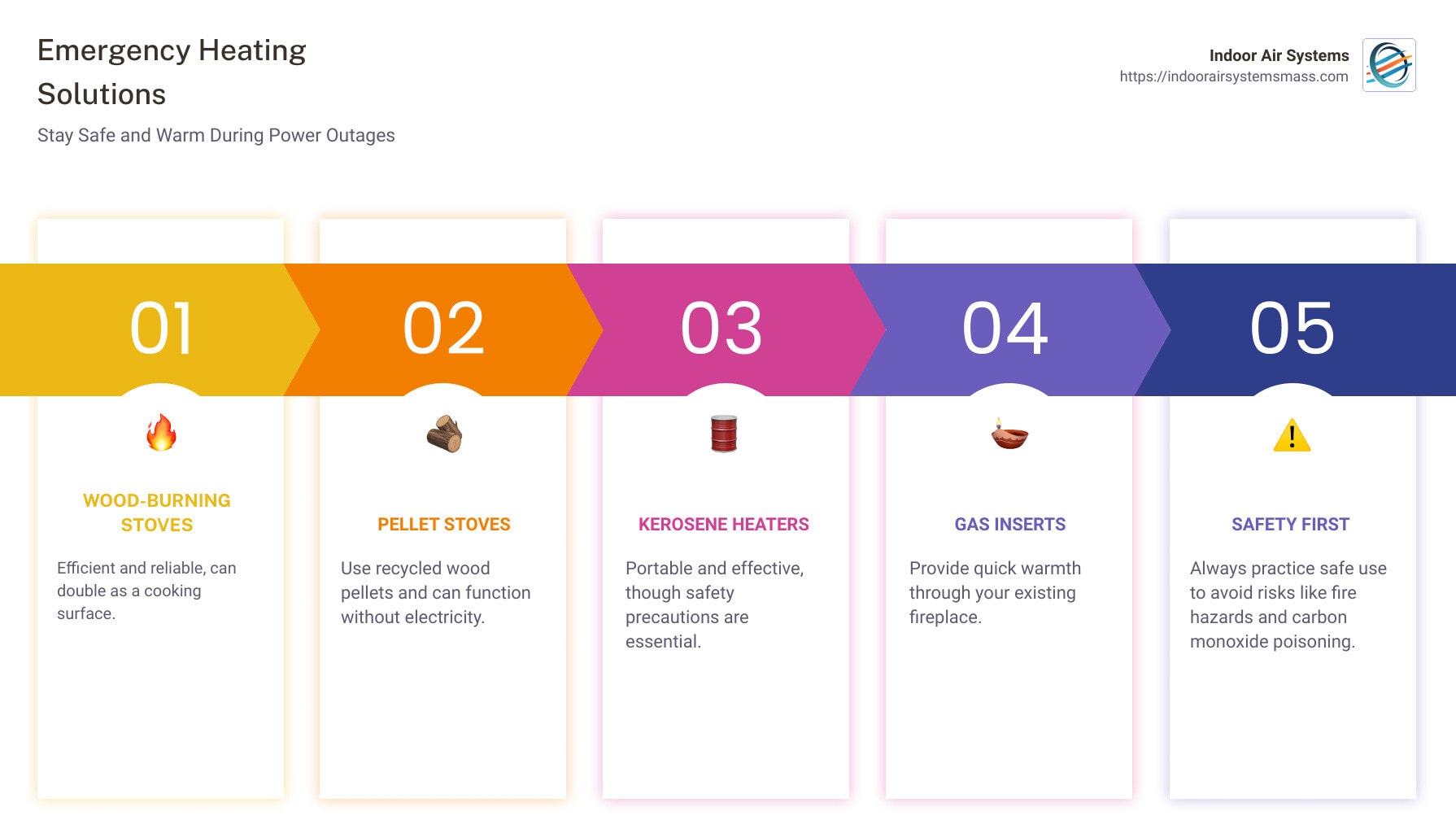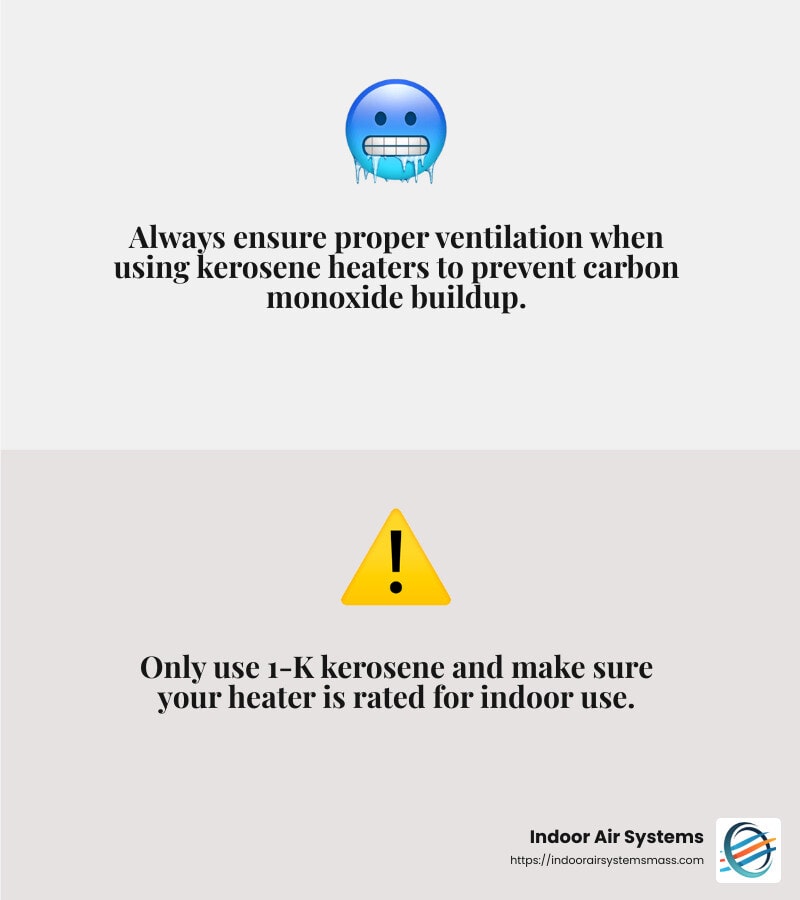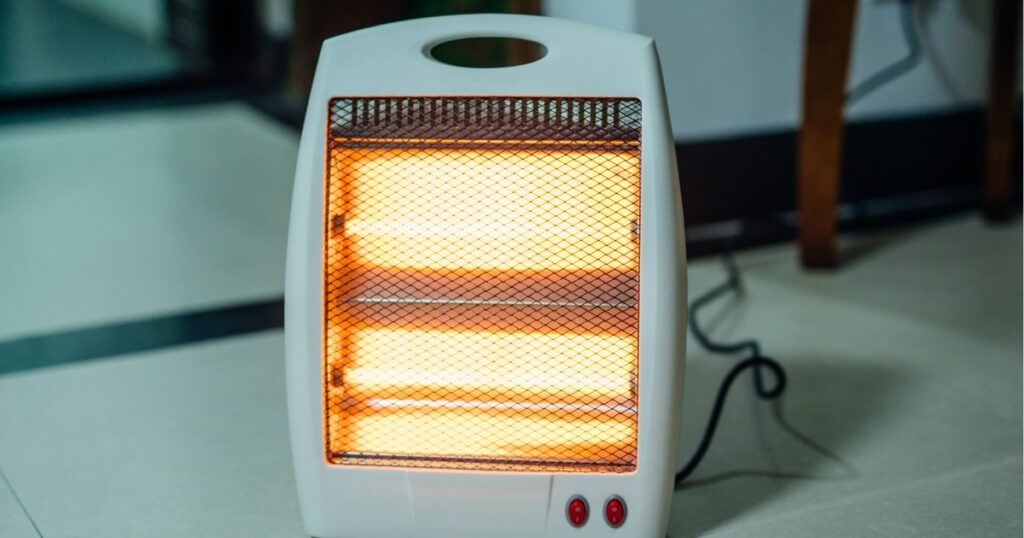Emergency home heating is crucial when facing unexpected power outages, especially during the cold Massachusetts winters. When the power goes out, you need solutions that not only keep you warm but are also safe and dependable. Here are some quick ways to ensure your home stays heated:
- Wood-Burning Stoves: Efficient, reliable, and can double as a cooking surface.
- Pellet Stoves: Use recycled wood pellets and can function without electricity.
- Kerosene Heaters: Portable and effective, though safety precautions are essential.
- Gas Inserts: Provide quick warmth through your existing fireplace.
In emergencies, keeping your home warm isn’t just about comfort—it’s about safety. Alternative heat sources like wood-burning stoves, pellet stoves, and kerosene heaters can offer peace of mind when the lights go out. However, using these options requires careful consideration. Risks like fire hazards and carbon monoxide poisoning are serious, so understanding how to use these heaters safely is important.
Being prepared with multiple heating solutions and knowing how to use them securely can make all the difference in keeping your family safe and warm during winter power outages.

Table of Contents
Understanding the Challenge of Heating During Power Outages
Heating during power outages can be a significant challenge, especially in colder climates. Freezing temperatures can pose serious health risks, particularly for children and the elderly. When the power goes out, alternative heat sources become essential backups to keep your home warm and safe.
Power outages can disrupt daily life in many ways, from charging phones to keeping food from spoiling. However, staying warm is one of the most critical challenges. Without electricity or natural gas, traditional heating systems become useless, leaving you vulnerable to the cold. Poor insulation can exacerbate the problem, allowing precious heat to escape.
Choosing the right alternative heat source can make a significant difference. Not only can it keep you warm during power outages, but it can also help reduce heating bills and provide year-round protection. Understanding the challenges and preparing accordingly ensures you stay safe and comfortable, no matter the weather.
Top Emergency Heating Solutions
When the power goes out, staying warm is not just a comfort—it’s a necessity. Here are some emergency home heatingsolutions that can keep your home cozy and safe during outages:
Electric Space Heaters
Electric space heaters are a convenient choice for emergency heating. They are efficient, portable, and can quickly warm up small areas. These heaters come in various sizes and styles, fitting well into different home designs. They require electricity to operate, so having a backup power source like a generator is essential.
Safety Tip: Ensure proper ventilation and use a carbon monoxide detector to prevent buildup of dangerous gases.
Infrared Heaters
Infrared heaters use radiant heat to warm objects and people directly, rather than heating the air. Some models can operate on battery power, making them a great option during power outages. They also don’t require a traditional chimney, as long as there is proper ventilation.
Advantages:
- Energy-efficient, using less electricity
- Can be more efficient than traditional space heaters
Gas Fireplaces
If you have an existing fireplace, a gas fireplace is a convenient option. It connects to your home’s gas line and provides instant warmth with the push of a button. Gas fireplaces are clean-burning and require professional installation, but they offer reliable heat when you need it most.
Fun Fact: Gas fireplaces can help reduce heating costs by efficiently warming a specific area of your home.
Portable Propane Heaters
Portable propane heaters are effective and versatile, making them a popular choice for emergency heating. However, they require careful handling. Always use propane heaters rated for indoor use and ensure proper ventilation to prevent carbon monoxide buildup.

Safety Tip: Keep a window slightly open for ventilation and have a battery-powered carbon monoxide detector nearby.
Catalytic Heaters
Catalytic heaters use propane or natural gas along with a catalyst to produce heat. They are efficient and provide consistent warmth without an open flame. Make sure the heater is secure and has adequate ventilation to operate safely indoors.
Why Choose Catalytic Heaters?
- No open flame reduces fire risk
- Efficient for small spaces
In conclusion, selecting the right emergency heating solution depends on your specific needs and home setup. Each option has its benefits and safety considerations, so be informed and prepared. By having a reliable heating plan in place, you can ensure comfort and safety for your family during unexpected power outages.
Choosing the Right Alternative Heat Source
Selecting the right alternative heat source is crucial for maintaining warmth and safety during a power outage. There are several options available, each with its own set of advantages and considerations.
Wood Burning Stoves: These stoves are a classic choice, providing reliable heat and a cozy ambiance. They can also double as a cooking surface in emergencies. However, they require a steady supply of wood and proper ventilation to prevent carbon monoxide buildup.
Pellet Stoves: Pellet stoves use recycled wood pellets and can operate without electricity, making them an efficient and eco-friendly option. They provide consistent heat but require regular maintenance and a supply of pellets.
Portable Propane Heaters: These heaters are versatile and effective, ideal for quick warmth. Ensure you choose models rated for indoor use and always maintain proper ventilation to avoid carbon monoxide poisoning.
Kerosene Heaters: Kerosene heaters are powerful and portable, offering substantial heat. However, they require careful handling and adherence to safety precautions, including the use of carbon monoxide detectors.
When choosing an alternative heat source, consider the following factors:
- Safety: Look for heaters with necessary safety features like carbon monoxide detectors and proper ventilation.
- Efficiency: Opt for energy-efficient models that provide consistent heat.
- Cost: Factor in the cost of the heater, fuel, and maintenance.
- Space: Choose a heater suitable for the space you intend to heat.
By weighing these factors, you can select the best alternative heat source to keep your home warm and safe during power outages.
DIY Emergency Heating Options

When you’re caught in a power outage, having a DIY emergency home heating option can be a lifesaver. These methods are simple, cost-effective, and can be done with materials you might already have at home.
It’s crucial to select a designated heated room during prolonged power outages to maximize warmth and conserve heating resources. Insulate the chosen space effectively by sealing windows and doors with blankets or towels. Close off other areas to ensure that the heating efforts are concentrated and efficient.
Candle Heaters
Candle heaters are a creative way to generate warmth using just a few household items. You’ll need some terracotta pots and candles. The idea is to trap the heat from the candles within the clay pots. Terracotta is porous, allowing it to absorb and then radiate heat, warming the surrounding area.
Quick Steps:
- Place a smaller pot upside down on a stand.
- Cover the pot’s hole with foil to keep heat in.
- Light a candle underneath and cover with a larger pot.
This setup creates a convection current, providing localized heat. It’s perfect for small spaces and can be a handy tool during emergencies.
Soapstone Heaters
Soapstone heaters are another effective DIY option. Soapstone absorbs heat and releases it slowly, making it a great heat retainer. Simply place a piece of soapstone near a heat source, like a wood stove, for about 30 minutes. Once heated, turn off the stove and let the soapstone radiate warmth into your room.
Benefits:
- Long-lasting heat retention
- Safe and natural
Camping Cooking Bags
Originally designed for cooking, camping cooking bags can also serve as an emergency heat source. These bags contain heat packs that, when activated with water, can generate enough heat to warm small areas.
How to Use:
- Fill the bag with boiling water.
- Seal it tightly.
- Place the bag in areas needing warmth.
The heat will gradually release, warming the surrounding space. Their compact size makes them a convenient choice for quick warmth.
Terracotta Pot Heater
For a more hands-on project, try a terracotta pot heater. This method is similar to the candle heater but uses canned heat for a more prolonged heating effect.
Steps:
- Set up a portable folding stove.
- Place a smaller terracotta pot upside down on the stove.
- Cover the hole with something non-flammable.
- Place a larger pot on top.
- Light the canned heat inside the stove.
This setup is ideal for both heating and cooking in emergencies, providing a warm, localized heat source.
Each of these DIY solutions offers a unique way to stay warm without electricity. They’re simple to set up, use readily available materials, and can be a real asset when traditional heating options aren’t available.
Passive and Environmental Heating Methods

When it comes to emergency home heating, passive and environmental methods offer sustainable and efficient ways to stay warm without relying on electricity. These strategies harness natural elements like the sun and wind, and they can be incredibly useful during power outages.
Passive Solar Heating
Passive solar heating is a smart way to capture and use the sun’s energy to warm your home. It involves using south-facing windows to let sunlight in, which is then absorbed by materials with high thermal mass like concrete, brick, or tile. These materials store the heat and release it slowly, keeping your house warm even after the sun sets.
Key Components:
- South-facing windows: Maximize sunlight exposure.
- Thermal mass: Use materials like brick or stone to store heat.
Even small changes, like opening curtains during the day and closing them at night, can make a difference.
Solar Air Systems
Solar air systems work by heating air with the sun’s energy and circulating it throughout your home. While installation can be complex and might require professional help, the benefits are significant. These systems can reduce your reliance on traditional heating methods and lower your energy bills.
How It Works:
- Collectors: Capture solar energy.
- Fans or vents: Distribute warm air inside your home.
Wind Systems
Wind systems convert wind energy into electricity, which can then be used to power your home’s heating appliances. Small wind turbines are becoming more popular as a backup energy source during power outages.
Advantages:
- Reduces heating bills.
- Provides clean energy.
Home Insulation
Good insulation is crucial for maintaining warmth during a power outage. It helps keep the heat inside your home, reducing the need for additional heating sources.
Tips for Effective Insulation:
- Seal air leaks: Use caulking and weatherstripping around windows and doors.
- Add insulation: Use foam board insulation on exterior walls.
- Use thick rugs and curtains: They can help retain heat.
Effective insulation can make a significant difference in how well your home retains heat, ensuring you stay warm even when the power is out.
These passive and environmental methods not only help in emergencies but also offer long-term benefits by reducing your energy consumption. By incorporating these strategies, you can create a more resilient and energy-efficient home environment.
Emergency Home Heating Safety Tips

When it comes to emergency home heating, safety is crucial. Here are key tips to ensure you stay warm without compromising your safety.
- Ensure proper ventilation to avoid carbon monoxide buildup.
- Use only approved heating devices and follow the manufacturer’s instructions.
- Keep flammable materials away from heat sources.
- Never leave heating devices unattended.
- Install carbon monoxide detectors and check them regularly.
- Have a fire extinguisher readily available.
- Select a designated heated room to maximize warmth and conserve heating resources. Insulate the chosen space effectively and use blankets to seal off other areas, concentrating heating efforts and ensuring safety during power outages.
Ventilation
Proper ventilation is essential when using combustion heaters. These heaters produce carbon monoxide, a dangerous gas that can build up indoors if not properly vented. Always leave a window or door slightly open to allow fresh air to circulate. This helps remove excess carbon monoxide and ensures a safe environment.
Carbon Monoxide Detectors
Carbon monoxide detectors are a must-have in any home using combustion heaters. Place battery-powered detectors on each floor and test them monthly to ensure they are working correctly. A working detector can alert you to dangerous gas levels, potentially saving lives.
Fuel Storage
Storing fuel safely is vital, especially for heaters that use kerosene or propane. Keep fuel in approved containers and store them away from heat sources and direct sunlight. This reduces the risk of fires or explosions. It’s also important to store enough fuel to last through an emergency, but never in excess that could become hazardous.
Practice Using Heating Sources
Familiarize yourself with your emergency heating devices before you need them. Practice using them in a controlled setting to understand how they operate and what accessories you might need. This preparation can reduce stress during an actual emergency, allowing you to focus on keeping warm.
By following these emergency home heating safety tips, you can ensure your family’s safety while staying warm during power outages or other emergencies. Proper preparation and caution can turn a potentially dangerous situation into a manageable one.
Creating Your Alternative Heating Action Plan
Creating an alternative heating action plan is essential to ensure you stay warm and safe during a power outage. Here are some steps to help you prepare:
- Assess Your Heating Needs: Determine how much heat you need to stay warm and comfortable. Consider the size of your home and the number of people.
- Choose an Alternative Heat Source: Select a heat source that meets your needs. Consider safety, efficiency, cost, and space when making your choice.
- Store Fuel Safely: Ensure you have enough fuel for your chosen heat source. Store it in approved containers, away from heat sources and direct sunlight, and follow necessary safety precautions.
- Designate a Heated Room: Choose a room to heat and isolate it from the rest of the home. This helps conserve energy and makes it easier to maintain a comfortable temperature.
- Minimize Heat Loss: Take steps to minimize heat loss by sealing windows and doors with weatherstripping and using heavy curtains to trap heat. This helps retain warmth and reduces the need for additional heating.
- Practice and Prepare: Familiarize yourself with your alternative heat source before you need it. Practice using it in a controlled setting to understand its operation and any accessories you might need. Prepare for emergencies by having necessary supplies and equipment on hand.
By following these steps, you can create an effective alternative heating action plan that ensures you stay warm and safe during power outages. Proper preparation and practice can make all the difference in managing an emergency situation.
Conclusion
When it comes to keeping your home warm during emergencies, having a reliable partner like Indoor Air Systems can make all the difference. Based in Central Massachusetts, we specialize in residential heating and cooling services, with a focus on personalized attention and responsiveness. Our expertise in mini-split systems, along with over 20 years of experience, ensures that you receive top-notch service without the burden of high overhead costs.
Contact us today at Indoor Air Systems. We understand that emergencies can be stressful, and that’s why we offer custom solutions to meet your unique needs. Whether you’re looking to install a new heating system or need advice on maintaining your current setup, our team is here to help. We pride ourselves on providing solutions that are not only effective but also safe and efficient.
For more information on how we can assist you with your home heating needs, visit our services page. Let us help you create a warm and comfortable home, even during unexpected power outages. With Indoor Air Systems, you’re in good hands.
Frequently Asked Questions about Emergency Home Heating
How do I heat my house in an emergency?
When you find yourself without power, keeping your home warm becomes a top priority. Here are some effective methods:
- Fireplace: A traditional option for warmth. If you have a wood-burning fireplace, keep a supply of dry wood on hand. It can provide substantial heat and create a cozy atmosphere.
- Space Heater: Portable space heaters can be a quick fix. Choose models that are safe for indoor use and have built-in safety features like tip-over protection. They need electricity, so they might not work in a power outage.
- Camping Stove: Originally for outdoor use, a camping stove can be a lifesaver. You can use it to heat small areas or cook warm meals. Ensure proper ventilation to avoid harmful fumes.
What is the best emergency heat source for a home?
Choosing the best emergency home heating source depends on your needs and resources:
- Candle Heater: This DIY option uses terracotta pots and candles. It’s simple and can provide a surprising amount of warmth for small spaces.
- Soapstone Heaters: Place soapstone in front of a heat source to absorb heat, then use it to radiate warmth slowly. It’s a natural and efficient way to keep warm.
- Emergency Heating Blankets: Lightweight and reflective, these blankets retain body heat. Perfect for wrapping up or layering on beds during chilly nights.
How to heat your house if power goes out?
Power outages require alternative heating solutions:
- Generator: A reliable backup that can power electric heaters or essential appliances. Make sure to use it outdoors to prevent carbon monoxide poisoning.
- Coal Stove: If you have one, it’s an excellent source of steady heat. Keep a supply of coal ready for emergencies.
- Propane Heater: These are powerful and portable. Use them with caution, ensuring proper ventilation to avoid gas buildup.
- Wood-Burning Stove: A versatile and reliable heating solution that does not require electricity or natural gas. It can also function as a cooking appliance when necessary.
By planning ahead and using these methods, you can stay warm and safe during unexpected outages. Always prioritize safety and ensure you have the right equipment and knowledge to handle emergencies effectively.
Our Content
At Indoor Air Systems, LLC, we provide specialized HVAC services with a personal touch. Serving Central Massachusetts, we focus on the installation and maintenance of mini-split systems, split system air conditioner, heating and cooling system, heating air, ensuring efficient and cost-effective heating and cooling solutions. Our locally owned and operated business allows us to offer exceptional customer attention and responsiveness without the high costs associated with larger companies. Choose Indoor Air Systems for reliable, expert service tailored to your specific needs.

